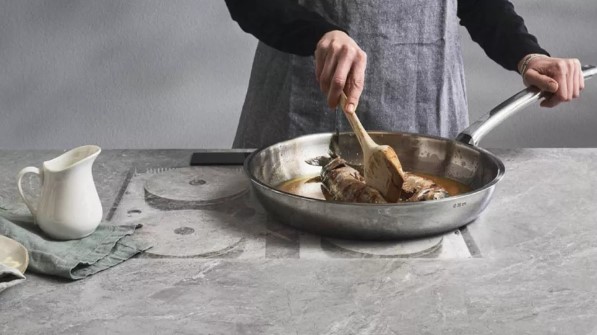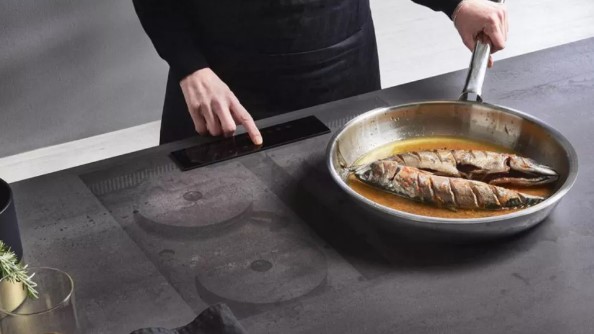What is an 'invisible hob' — and is it a good idea?
We take a look at this unique kitchen appliance and give you the pros and cons and let you decide whether you should install the 'Invisible hob' into your home

Those seeking the ultimate, uninterrupted kitchen look might be curious about this secret "invisible hob" you can buy that is hidden under your kitchen worktop.
The fact that "invisible' hobs" are under your worktop means you are actually cooking on your countertop rather than on a physical hob integrated into the surface. They work by using magnets under your kitchen worktops — an alternative way of cooking to the best range cookers on the market.
Here we take a look at the positives and negatives of the kitchen appliance and whether it would be suitable for your kitchen.
What is an 'Invisible hob'?
An invisible hob sits beneath your countertop, meaning it blends in the aesthetics of your worktops. You can pick one with a single, double, or four burners, but it needs a special countertop like granite or porcelain to function.
These burners use magnets to heat up your pots and pans, and only the pots and pans get hot, not the stovetop itself, although this can itself make the worktop very hot. Invisible hobs also only heat up when there's a pan on it, making it safer than you might expect.
Kitchen countertops like Invisacook have induction hobs that can be positioned just under the countertop, heating the pans through the surface https://t.co/IcwEI8y5bS [read more about induction cooking: https://t.co/iSmxIFOGDz] pic.twitter.com/8IKhV3oPqVAugust 15, 2022
What are the benefits of an invisible hob?
Manufacturers of invisible hobs claim to offer many advantages to your kitchen, including:
1. Energy efficiency — Invisible hobs heat up quicker and use less energy, making your cooking faster and greener and provides an energy efficient appliances option. Plus, it's safer too. It only heats the pan, not the whole stove, and won't work unless there's a pan on it.
2. Maximises space — One major advantage of invisible stovetops is their space-saving design. By integrating the stove into your countertop, you're making the most of your space. This is especially great if your kitchen is on the smaller side.
3. Appearance — Another benefit is how an invisible stovetop enhances your kitchen's visual appeal. It creates a sleek, seamless surface and gets rid of the unattractive sight of a bulky black stove. The chosen countertop material, whether it's granite or porcelain, adds a touch of luxury, making it a truly stylish addition and could help you when making a choice between ceramic vs induction hobs.
4. Wifi connectivity — Some invisible hob manufacturers like Invisacook include Wi-Fi connectivity with their hobs, which adds a further element of safety to its design as you can remotely make sure they are turned off.
5. Less cleaning hassle than gas — If you're considering switching from gas to induction, you'll enjoy some perks. Induction hobs have a smooth surface that's easy to wipe clean, whereas gas hobs and grates can be tricky to clean.

What problems come with invisible hobs?
It isn't all sunshine and roses those as there are some issues that come with invisible hobs, such as:
1. Leaves leftover heat — Heat will only be transferred onto pots and pans, however, the pots and pans themselves can transfer heat onto the kitchen surface. Invisicook states on its website: "The surface will get warmer and warmer over time as you cook, eventually becoming hot to the touch. For your standard short cooking time, the surface will not get that hot. However, once you have surpassed about 10 minutes’ worth of cooking time, the surface will be hot and you should exercise caution around the area in use."
2. Only works on certain surfaces — If you have your heart set on a surface material other than granite and porcelain then this hob might not be for you. Invisible hobs can only transfer heat using these types of surfaces.
3. Only certain pans can be used too — Similar to the surfaces, only certain pots and pans can be used with the invisible hob too. These hobs can only be used with pots that are magnetic, so cast iron, glass and copper materials will not be compatible.
4. Regular cleaning needed — Although it may be easier to clean, invisible hobs can leave black marks on your kitchen tops and require regular cleaning, unless you want your pristine kitchen surface to have marks.
5. It's costly — It's no surprise that this technology comes with a high price tag. The total expense will vary based on the stove size and the countertop requirements. Keep in mind that invisible stovetops only work with specific surfaces, which can drive up the overall cost. Silestone Central estimates that for your average four burner invisible hob, it'll set you back around $3,000 (£2.300) and this price will vary depending on your stockist.

Should I buy an invisible hob for my kitchen?
There's no doubt the invisible hob is clever and provides a lot of solutions to a lot of kitchen problems, but whether it is worth buying for your kitchen design depends on a number of factors.
If you are looking for space saving features as well as innovation in your kitchen (and the budget to do so) then the invisible hob could be perfect for your design.
But it might not be suitable for those with smaller budgets and little time to spend on keeping your worktop surface clear.
Get the Homebuilding & Renovating Newsletter
Bring your dream home to life with expert advice, how to guides and design inspiration. Sign up for our newsletter and get two free tickets to a Homebuilding & Renovating Show near you.

News Editor Joseph has previously written for Today’s Media and Chambers & Partners, focusing on news for conveyancers and industry professionals. Joseph has just started his own self build project, building his own home on his family’s farm with planning permission for a timber frame, three-bedroom house in a one-acre field. The foundation work has already begun and he hopes to have the home built in the next year. Prior to this he renovated his family's home as well as doing several DIY projects, including installing a shower, building sheds, and livestock fences and shelters for the farm’s animals. Outside of homebuilding, Joseph loves rugby and has written for Rugby World, the world’s largest rugby magazine.
